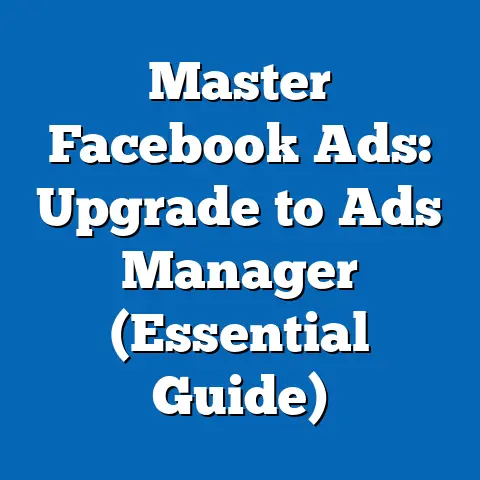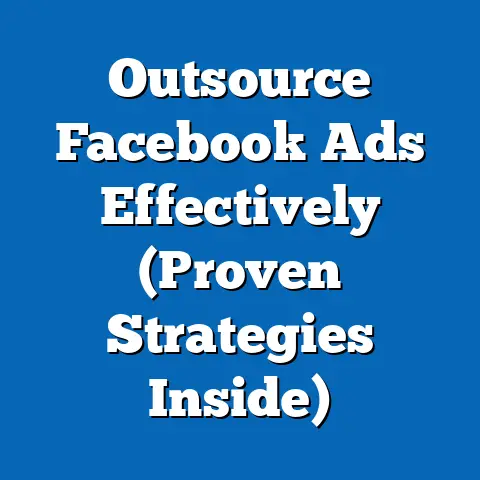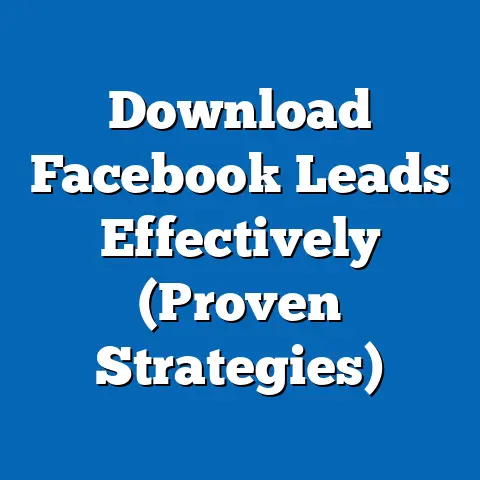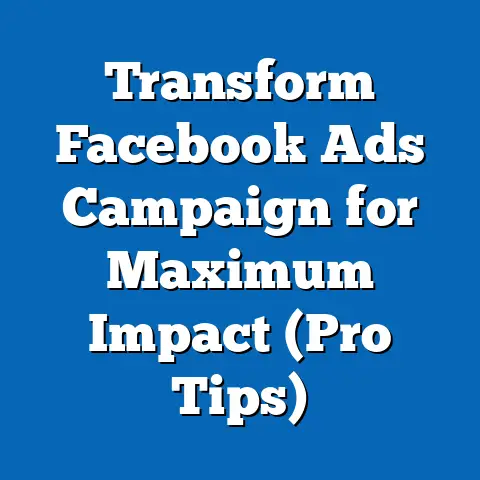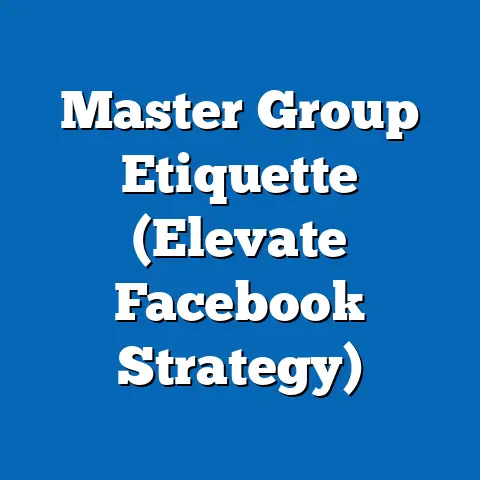Conversions vs. Store Visits in Facebook Ads (Strategic Insights)
Imagine a painter standing before a vast, blank canvas, a palette brimming with vibrant colors at their side. Each color represents a different advertising strategy, a different approach to reach an audience and achieve a desired outcome. But which color to choose? Which strategy will create a masterpiece of marketing success? In the vibrant world of Facebook Ads, what truly drives success – conversions or store visits? This question is at the heart of every marketing campaign, and understanding the nuances of these two crucial metrics is the key to unlocking your advertising potential.
For years, I’ve helped businesses navigate the ever-changing landscape of Facebook advertising. I’ve seen firsthand how a deep understanding of metrics can transform a struggling campaign into a roaring success. I’ve also witnessed the frustration that comes from chasing the wrong numbers, leading to wasted ad spend and missed opportunities.
This guide is designed to equip you with the knowledge and insights you need to confidently navigate the world of conversions and store visits in Facebook Ads. We’ll delve into the definitions, explore the tracking methodologies, compare the pros and cons, and ultimately, help you determine which metric (or combination of metrics) is right for your unique business goals. So, grab your digital brush, and let’s start painting a clearer picture of your Facebook advertising success!
Section 1: Understanding Facebook Ads Metrics
Before we dive into the specifics, let’s lay the groundwork by defining our key terms and understanding why these metrics are so vital.
Definition of Key Terms
-
Conversion: In the context of Facebook Ads, a conversion is a specific action a user takes after interacting with your ad that you’ve defined as valuable. This could be anything from making a purchase on your website to signing up for a newsletter, downloading a resource, or filling out a contact form. Essentially, it’s a user completing a desired goal.
- Example: Imagine you’re selling handmade jewelry online. A conversion could be a customer adding a necklace to their cart, proceeding to checkout, and completing the purchase.
-
Store Visit: A store visit refers to a physical visit to your brick-and-mortar store by a user who has been exposed to your Facebook ad. It’s a powerful metric for businesses with physical locations, as it directly connects online advertising efforts to real-world foot traffic.
-
Example: Let’s say you run a local coffee shop and run a Facebook ad promoting a new seasonal latte. A store visit would be a customer who saw your ad and then visited your coffee shop within a defined timeframe, as tracked by Facebook.
Conversion: In the context of Facebook Ads, a conversion is a specific action a user takes after interacting with your ad that you’ve defined as valuable. This could be anything from making a purchase on your website to signing up for a newsletter, downloading a resource, or filling out a contact form. Essentially, it’s a user completing a desired goal.
- Example: Imagine you’re selling handmade jewelry online. A conversion could be a customer adding a necklace to their cart, proceeding to checkout, and completing the purchase.
-
Store Visit: A store visit refers to a physical visit to your brick-and-mortar store by a user who has been exposed to your Facebook ad. It’s a powerful metric for businesses with physical locations, as it directly connects online advertising efforts to real-world foot traffic.
-
Example: Let’s say you run a local coffee shop and run a Facebook ad promoting a new seasonal latte. A store visit would be a customer who saw your ad and then visited your coffee shop within a defined timeframe, as tracked by Facebook.
Store Visit: A store visit refers to a physical visit to your brick-and-mortar store by a user who has been exposed to your Facebook ad. It’s a powerful metric for businesses with physical locations, as it directly connects online advertising efforts to real-world foot traffic.
Example: Let’s say you run a local coffee shop and run a Facebook ad promoting a new seasonal latte. A store visit would be a customer who saw your ad and then visited your coffee shop within a defined timeframe, as tracked by Facebook.
Importance of Metrics
So, why should you even care about these metrics? The answer is simple: data-driven decision-making. In today’s competitive landscape, relying on gut feeling alone is a recipe for disaster. Understanding your metrics allows you to:
- Measure Campaign Effectiveness: Are your ads actually working? Are they driving the desired actions? Metrics provide concrete evidence of your campaign’s performance.
- Optimize for Better Results: By analyzing your metrics, you can identify what’s working and what’s not. You can then tweak your ad copy, targeting, bidding strategies, and more to improve your results.
- Maximize ROI: Ultimately, you want to get the most bang for your buck. By focusing on the right metrics and optimizing your campaigns accordingly, you can increase your return on investment (ROI).
- Understand Customer Behavior: Metrics can provide valuable insights into how your audience interacts with your brand. This understanding can inform not only your advertising strategy but also your overall marketing and business strategy.
I remember working with a local bookstore that was struggling to attract new customers. They were running Facebook ads, but they weren’t seeing any noticeable impact on their sales. By diving into their metrics, we discovered that while their ads were generating clicks, they weren’t leading to conversions (i.e., purchases on their website). We then realized that their website’s checkout process was clunky and confusing. By simplifying the checkout process, we saw a significant increase in conversions and, ultimately, a boost in their online sales. This experience highlighted the importance of not just tracking metrics but also understanding the story they tell.
Key Takeaway: Understanding and tracking both conversions and store visits provides crucial insights into your campaign performance, allowing you to optimize your strategy, maximize your ROI, and understand your customer behavior.
Section 2: The Conversion Metric
Let’s zoom in on the conversion metric and explore it in more detail.
What is a Conversion?
As mentioned earlier, a conversion is a specific action a user takes that you’ve defined as valuable. However, the specific type of conversion will vary depending on your business goals. Here are some common examples:
- Purchases: The most straightforward conversion, representing a completed transaction on your website.
- Lead Generation: Capturing potential customer information, such as email addresses or phone numbers, through forms or sign-ups.
- Sign-ups: Users creating accounts on your website or subscribing to your newsletter.
- Downloads: Users downloading resources like e-books, white papers, or software.
- Form Submissions: Users filling out contact forms, quote requests, or other types of forms.
- App Installs: Users installing your mobile app after clicking on your ad.
- Page Views: Users visiting specific pages on your website, such as product pages or landing pages. (While less direct, this can indicate interest and be a micro-conversion).
- Add to Cart: Users adding products to their shopping cart (a valuable indicator of purchase intent).
The key is to define what a conversion means for your business. What actions do you want users to take after seeing your ad? Once you’ve defined your conversions, you can track them and optimize your campaigns accordingly.
How Facebook Tracks Conversions
Facebook uses a powerful tool called the Facebook Pixel to track conversions. The Facebook Pixel is a small snippet of code that you place on your website. This code allows Facebook to track user actions on your website and attribute those actions to your Facebook ads.
Here’s a simplified explanation of how it works:
- User Clicks Ad: A user sees your Facebook ad and clicks on it, landing on your website.
- Pixel Fires: The Facebook Pixel on your website detects the user’s activity (e.g., viewing a product page, adding an item to their cart, completing a purchase).
- Data Sent to Facebook: The Pixel sends data about the user’s activity back to Facebook.
- Conversion Attributed: Facebook then attributes the conversion (the specific action the user took) to the original ad that the user clicked on.
The Facebook Pixel is incredibly versatile and allows you to track a wide range of conversions. You can even create custom conversions based on specific URLs or events on your website.
Setting up the Facebook Pixel is crucial for tracking conversions. Here’s a quick overview:
- Create a Pixel: Go to the Facebook Ads Manager and create a new Pixel.
- Install the Code: Copy the Pixel code and paste it into the
<head>section of every page on your website. - Set Up Events: Define the specific events you want to track (e.g., purchases, lead form submissions) and add the appropriate event code to the corresponding pages on your website.
I remember helping a small e-commerce business set up their Facebook Pixel for the first time. They were initially hesitant because they thought it was too technical. However, after walking them through the process step-by-step, they were amazed at how easy it was and how much valuable data they could now track. They immediately started seeing improvements in their campaign performance as they were able to optimize for conversions.
Analyzing Conversion Rates
A conversion rate is the percentage of users who complete a desired action (a conversion) out of the total number of users who interacted with your ad (usually, clicked on your ad). It’s a critical metric for measuring the effectiveness of your campaigns.
Formula:
Conversion Rate = (Number of Conversions / Number of Clicks) x 100%
Example: If 100 users click on your ad and 5 of them make a purchase, your conversion rate is 5%.
Interpreting Conversion Rates:
What constitutes a “good” conversion rate varies depending on several factors, including:
- Industry: Some industries naturally have higher conversion rates than others.
- Product/Service: Complex or expensive products/services may have lower conversion rates than simpler or more affordable ones.
- Target Audience: Highly targeted audiences tend to convert at higher rates.
- Ad Creative: Compelling ad copy and visuals can significantly impact conversion rates.
- Landing Page Experience: A user-friendly and optimized landing page is crucial for driving conversions.
While there’s no one-size-fits-all answer, here are some general benchmarks:
- E-commerce: Average conversion rates typically range from 1% to 3%.
- Lead Generation: Average conversion rates can range from 3% to 5% or higher.
It’s important to benchmark your conversion rates against industry averages and track your own performance over time to identify areas for improvement.
Factors Affecting Conversion Rates:
- Ad Relevance: Are your ads relevant to your target audience?
- Landing Page Optimization: Is your landing page clear, concise, and easy to navigate?
- Call to Action (CTA): Is your CTA clear and compelling?
- Website Speed: Is your website loading quickly?
- Mobile Optimization: Is your website optimized for mobile devices?
- Trust Signals: Are you displaying trust signals like customer reviews and security badges?
Real-World Examples
Let’s look at some real-world examples of businesses that have successfully utilized conversion-focused campaigns:
-
Example 1: E-commerce Brand (Fashion Retailer)
- Goal: Increase online sales.
- Strategy: Ran Facebook ads targeting users interested in fashion and specific clothing styles. Used dynamic product ads to showcase relevant products based on user browsing history.
- Results: Saw a 30% increase in online sales and a 20% increase in conversion rate.
- Key Takeaway: Personalized ads and retargeting are highly effective for driving e-commerce conversions.
-
Example 2: SaaS Company (Software as a Service)
-
Goal: Generate leads for their software product.
- Strategy: Created a lead magnet (a free e-book) and promoted it through Facebook ads targeting professionals in their industry. Used lead forms to capture contact information directly within Facebook.
- Results: Generated a 50% increase in leads and a 15% decrease in cost per lead.
- Key Takeaway: Offering valuable content in exchange for contact information is a great way to generate leads through Facebook ads.
-
Example 3: Local Service Business (Plumber)
-
Goal: Drive appointment bookings.
- Strategy: Ran Facebook ads targeting homeowners in their service area. Used a clear and compelling call to action (e.g., “Book Your Appointment Today”).
- Results: Saw a 25% increase in appointment bookings and a 10% increase in website traffic.
- Key Takeaway: Local businesses can effectively use Facebook ads to drive appointment bookings by targeting users in their service area.
Example 1: E-commerce Brand (Fashion Retailer)
- Goal: Increase online sales.
- Strategy: Ran Facebook ads targeting users interested in fashion and specific clothing styles. Used dynamic product ads to showcase relevant products based on user browsing history.
- Results: Saw a 30% increase in online sales and a 20% increase in conversion rate.
- Key Takeaway: Personalized ads and retargeting are highly effective for driving e-commerce conversions.
-
Example 2: SaaS Company (Software as a Service)
-
Goal: Generate leads for their software product.
- Strategy: Created a lead magnet (a free e-book) and promoted it through Facebook ads targeting professionals in their industry. Used lead forms to capture contact information directly within Facebook.
- Results: Generated a 50% increase in leads and a 15% decrease in cost per lead.
- Key Takeaway: Offering valuable content in exchange for contact information is a great way to generate leads through Facebook ads.
-
Example 3: Local Service Business (Plumber)
-
Goal: Drive appointment bookings.
- Strategy: Ran Facebook ads targeting homeowners in their service area. Used a clear and compelling call to action (e.g., “Book Your Appointment Today”).
- Results: Saw a 25% increase in appointment bookings and a 10% increase in website traffic.
- Key Takeaway: Local businesses can effectively use Facebook ads to drive appointment bookings by targeting users in their service area.
Example 2: SaaS Company (Software as a Service)
Goal: Generate leads for their software product.
Example 3: Local Service Business (Plumber)
Goal: Drive appointment bookings.
Key Takeaway: Conversions are specific actions that you define as valuable, and the Facebook Pixel is the key to tracking them. Analyzing conversion rates and optimizing your campaigns accordingly can significantly improve your results.
Section 3: The Store Visits Metric
Now, let’s shift our focus to the store visits metric and explore its unique value proposition.
Understanding Store Visits
Store visits, as we’ve discussed, represent the number of people who visit your physical store after seeing your Facebook ad. This metric is particularly valuable for businesses that rely on foot traffic, such as:
- Retail Stores: Clothing stores, bookstores, electronics stores, etc.
- Restaurants and Cafes: Coffee shops, diners, fast-food restaurants, etc.
- Service Businesses: Salons, spas, gyms, etc.
- Local Businesses: Any business with a physical location that relies on local customers.
While online conversions are crucial for e-commerce businesses, store visits provide a direct link between your online advertising efforts and your offline sales.
Differentiating Online and Physical Store Visits:
It’s important to distinguish between online conversions and physical store visits. Online conversions represent actions taken on your website or app, while store visits represent actual visits to your physical location. Both are valuable, but they measure different aspects of your business.
The Value of Foot Traffic
Why is measuring store visits so crucial for businesses with physical locations? Here’s why:
- Direct Impact on Sales: Increased foot traffic directly translates to increased sales opportunities. More people in your store means more potential customers browsing your products and making purchases.
- Brand Awareness: Store visits contribute to overall brand awareness. Even if a customer doesn’t make a purchase during their visit, they are still exposed to your brand and your products, which can lead to future sales.
- Customer Loyalty: Physical store visits can foster stronger customer relationships. Customers who visit your store are more likely to feel a connection to your brand and become loyal customers.
- Data-Driven Insights: Tracking store visits provides valuable data that can inform your overall marketing strategy. You can see which ads are driving the most foot traffic and optimize your campaigns accordingly.
I worked with a local bakery that was struggling to compete with larger chain stores. They were running Facebook ads, but they weren’t sure if they were actually driving any customers to their bakery. By tracking store visits, we were able to see that their ads were indeed driving foot traffic, but the conversion rate (the percentage of visitors who made a purchase) was low. We then realized that their in-store experience was lacking. By improving their customer service, offering samples, and creating a more inviting atmosphere, they were able to increase their conversion rate and significantly boost their sales. This experience highlighted the importance of not just driving foot traffic but also creating a positive in-store experience.
How Facebook Measures Store Visits
Facebook uses a combination of technologies to track store visits:
- Location Services: Facebook relies on users’ location services being enabled on their mobile devices.
- Wi-Fi Signals: Facebook can detect when a user’s device connects to the Wi-Fi network at your store.
- GPS Data: Facebook uses GPS data to determine if a user has visited your store.
- Business Page Check-ins: When users check into your business on Facebook, it’s counted as a store visit.
Facebook then aggregates this data to provide you with an estimated number of store visits attributed to your Facebook ads.
Accuracy of Store Visit Data:
It’s important to note that store visit data is an estimate. It’s not a perfect measurement, as it relies on users’ location services being enabled and other factors. However, it provides a valuable indicator of the impact of your Facebook ads on foot traffic.
Requirements for Tracking Store Visits:
- Physical Location: You must have a physical store location.
- Facebook Business Page: You must have a Facebook Business Page for your store.
- Accurate Address: Your address on your Facebook Business Page must be accurate.
- Location Services Enabled: Users must have location services enabled on their mobile devices.
Impact of Store Visits on Business
Increased store visits can have a significant impact on your business:
- Increased Sales: As mentioned earlier, more foot traffic directly translates to more sales opportunities.
- Higher Brand Awareness: Store visits increase brand visibility and recognition.
- Improved Customer Loyalty: Physical store visits can foster stronger customer relationships.
- Valuable Data Insights: Tracking store visits provides valuable data that can inform your overall marketing strategy.
- Competitive Advantage: By effectively driving store visits, you can gain a competitive advantage over businesses that don’t utilize this metric.
Key Takeaway: Store visits are a valuable metric for businesses with physical locations, providing a direct link between online advertising efforts and offline sales. Tracking store visits can help you increase sales, improve brand awareness, and gain a competitive advantage.
Section 4: Comparative Analysis: Conversions vs. Store Visits
Now that we’ve explored both conversions and store visits in detail, let’s compare them side-by-side to help you determine which metric is right for your business.
Objective Comparison
Here’s a table summarizing the pros and cons of focusing on conversions versus store visits in Facebook Ads:
| Feature | Conversions | Store Visits |
|---|---|---|
| Definition | Specific actions taken online after interacting with your ad (e.g., purchase, sign-up). | Physical visits to your brick-and-mortar store after seeing your Facebook ad. |
| Best For | Businesses with online sales or lead generation goals. | Businesses with physical locations that rely on foot traffic. |
| Tracking | Facebook Pixel tracks user actions on your website or app. | Facebook uses location services, Wi-Fi signals, and GPS data to estimate store visits. |
| Pros | * Directly measures online ROI.* Provides detailed data on user behavior on your website.* Easy to track and optimize. | * Connects online advertising to offline sales.* Increases foot traffic and brand awareness.* Fosters customer loyalty. |
| Cons | * May not be relevant for businesses with primarily offline sales.* Requires a well-optimized website or app. | * Data is an estimate and may not be perfectly accurate.* Requires users to have location services enabled.* May not be relevant for businesses without physical locations. |
| Cost | Cost per Conversion (CPC) can vary depending on industry and targeting. | Cost per Store Visit can vary depending on location and targeting. |
| Optimization | Optimize for specific actions (e.g., purchases, leads) by targeting relevant audiences and creating compelling ad copy. | Optimize for foot traffic by targeting local audiences and promoting special offers or events at your store. |
| Feature | Conversions | Store Visits |
|---|---|---|
| Definition | Specific actions taken online after interacting with your ad (e.g., purchase, sign-up). | Physical visits to your brick-and-mortar store after seeing your Facebook ad. |
| Best For | Businesses with online sales or lead generation goals. | Businesses with physical locations that rely on foot traffic. |
| Tracking | Facebook Pixel tracks user actions on your website or app. | Facebook uses location services, Wi-Fi signals, and GPS data to estimate store visits. |
| Pros | * Directly measures online ROI.* Provides detailed data on user behavior on your website.* Easy to track and optimize. | * Connects online advertising to offline sales.* Increases foot traffic and brand awareness.* Fosters customer loyalty. |
| Cons | * May not be relevant for businesses with primarily offline sales.* Requires a well-optimized website or app. | * Data is an estimate and may not be perfectly accurate.* Requires users to have location services enabled.* May not be relevant for businesses without physical locations. |
| Cost | Cost per Conversion (CPC) can vary depending on industry and targeting. | Cost per Store Visit can vary depending on location and targeting. |
| Optimization | Optimize for specific actions (e.g., purchases, leads) by targeting relevant audiences and creating compelling ad copy. | Optimize for foot traffic by targeting local audiences and promoting special offers or events at your store. |
When to Prioritize Each Metric
So, when should you prioritize conversions and when should you prioritize store visits? Here are some specific scenarios:
- Prioritize Conversions If:
- You primarily sell products or services online.
- Your goal is to generate leads for your business.
- You want to track specific actions taken on your website or app.
- You have a well-optimized website or app that is designed to drive conversions.
- Prioritize Store Visits If:
- You rely on foot traffic to drive sales.
- You want to increase brand awareness in your local area.
- You want to foster stronger customer relationships through in-store experiences.
- You have a physical store location that is easily accessible to your target audience.
- You primarily sell products or services online.
- Your goal is to generate leads for your business.
- You want to track specific actions taken on your website or app.
- You have a well-optimized website or app that is designed to drive conversions.
- You rely on foot traffic to drive sales.
- You want to increase brand awareness in your local area.
- You want to foster stronger customer relationships through in-store experiences.
- You have a physical store location that is easily accessible to your target audience.
I often tell my clients that the best metric to focus on is the one that directly aligns with their business goals. If your goal is to drive online sales, then conversions should be your primary focus. If your goal is to increase foot traffic to your physical store, then store visits should be your primary focus.
Integrating Both Metrics
But what if you want to achieve both online and offline success? Can you integrate both conversions and store visits into a single, cohesive strategy? The answer is a resounding yes!
Here’s how you can leverage both metrics to create a more holistic marketing strategy:
- Promote Online and Offline Offers: Run Facebook ads that promote both online discounts and in-store promotions. This can encourage users to either make a purchase online or visit your store.
- Use Location-Based Targeting: Target users in your local area with ads that promote your store and its products or services. Include a call to action that encourages them to visit your store.
- Track Both Conversions and Store Visits: Monitor both metrics to see which ads are driving the most online and offline results.
- Retarget Website Visitors: Retarget users who have visited your website with ads that promote your store and its products or services. This can encourage them to visit your store and make a purchase.
- Create a Seamless Customer Experience: Ensure that your online and offline experiences are consistent and complementary. This can help build trust and loyalty with your customers.
For example, a clothing store could run Facebook ads promoting a new collection online while also offering a discount for customers who visit their store and mention the ad. This integrated approach can drive both online sales and in-store foot traffic.
Key Takeaway: Both conversions and store visits are valuable metrics, but they are best suited for different business goals. Integrating both metrics into a single strategy can help you achieve both online and offline success.
Section 5: Strategic Insights and Recommendations
Now that you have a solid understanding of conversions and store visits, let’s explore some strategic insights and recommendations to help you optimize your Facebook Ads campaigns.
Creating a Data-Driven Strategy
The key to success in Facebook advertising is to create a data-driven strategy. This means using data to inform your decisions and continuously optimizing your campaigns based on the results.
Here are some tips for creating a data-driven strategy:
- Set Clear Goals: Define what you want to achieve with your Facebook Ads campaigns (e.g., increase online sales, generate leads, drive store visits).
- Track Your Metrics: Monitor your conversions, store visits, and other relevant metrics on a regular basis.
- Analyze Your Data: Look for patterns and trends in your data. Which ads are performing well? Which audiences are converting at the highest rates?
- Test and Experiment: Continuously test new ad copy, visuals, targeting options, and bidding strategies.
- Optimize Your Campaigns: Based on your data analysis, make adjustments to your campaigns to improve your results.
- Use A/B Testing: A/B testing allows you to compare two versions of an ad (A and B) to see which one performs better. This is a great way to test different ad copy, visuals, and calls to action.
I always advise my clients to view their Facebook Ads campaigns as an ongoing experiment. The key is to continuously test, learn, and adapt based on the data.
Targeting and Segmentation
Audience targeting and segmentation are crucial for improving both conversions and store visits. By targeting the right audience with the right message, you can significantly increase your chances of success.
Here are some targeting options to consider:
- Demographics: Target users based on age, gender, location, education, and other demographic factors.
- Interests: Target users based on their interests and hobbies.
- Behaviors: Target users based on their online behavior, such as their purchase history or website visits.
- Custom Audiences: Create custom audiences based on your existing customer data, such as email lists or website visitors.
- Lookalike Audiences: Create lookalike audiences based on your custom audiences. These are users who share similar characteristics to your existing customers.
- Location Targeting: Target users in your local area to drive store visits.
Segmentation is the process of dividing your audience into smaller groups based on shared characteristics. This allows you to create more targeted and relevant ads for each segment.
For example, you could segment your audience based on their purchase history. You could then create ads that promote products that are relevant to their past purchases.
Ad Creative and Messaging
Your ad creative and messaging play a critical role in driving both conversions and store visits. Your ads should be visually appealing, engaging, and relevant to your target audience.
Here are some tips for creating effective ad creative:
- Use High-Quality Images or Videos: Your visuals should be clear, professional, and relevant to your product or service.
- Write Compelling Ad Copy: Your ad copy should be concise, engaging, and persuasive.
- Include a Clear Call to Action: Tell users what you want them to do (e.g., “Shop Now,” “Learn More,” “Visit Our Store”).
- Highlight Benefits, Not Just Features: Focus on the benefits that your product or service provides to the user.
- Use Social Proof: Include customer reviews or testimonials to build trust and credibility.
- Match Your Ad Copy to Your Landing Page: Ensure that your ad copy is consistent with the messaging on your landing page.
For driving store visits, consider these additional tips:
- Showcase Your Store: Use images or videos that showcase your store’s interior or exterior.
- Highlight Special Offers: Promote special offers or events that are happening at your store.
- Provide Directions: Include a map or directions to your store.
- Use Location Extensions: Use location extensions to display your address and phone number in your ad.
Key Takeaway: Creating a data-driven strategy, targeting the right audience, and crafting compelling ad creative are all essential for optimizing your Facebook Ads campaigns for both conversions and store visits.
Section 6: Future Trends in Facebook Ads
The world of Facebook Ads is constantly evolving, with new technologies and trends emerging all the time. To stay ahead of the curve, it’s important to understand these future trends and how they might impact your advertising strategy.
Emerging Technologies
- AI and Machine Learning: AI and machine learning are playing an increasingly important role in Facebook Ads. Facebook is using AI to automate many aspects of advertising, such as ad targeting, bidding, and optimization. AI-powered tools can also help you create more personalized and relevant ads for your audience.
- Augmented Reality (AR): AR is starting to make its way into Facebook Ads. AR ads allow users to virtually try on products or experience a brand in a more immersive way. This can be particularly effective for driving conversions for e-commerce businesses.
- Virtual Reality (VR): While still in its early stages, VR has the potential to transform the way we interact with ads. VR ads could allow users to virtually visit your store or experience your product in a completely new way.
Changing Consumer Behavior
- Mobile-First: Mobile devices are now the primary way that people access the internet. This means that your Facebook Ads need to be optimized for mobile devices.
- Video Consumption: Video is becoming increasingly popular on Facebook. Video ads are more engaging than static image ads and can be highly effective for driving both conversions and store visits.
- Privacy Concerns: Consumers are becoming increasingly concerned about their privacy online. This means that you need to be transparent about how you are collecting and using their data.
- Personalization: Consumers expect personalized experiences from brands. This means that you need to create ads that are relevant to their individual interests and needs.
Preparing for the Future
Here are some tips for preparing for the future of Facebook Ads:
- Embrace AI and Machine Learning: Learn how to use AI-powered tools to automate your advertising and create more personalized ads.
- Optimize for Mobile: Ensure that your website and ads are optimized for mobile devices.
- Invest in Video: Create engaging video ads that capture attention and drive results.
- Be Transparent About Privacy: Be clear about how you are collecting and using user data.
- Focus on Personalization: Create ads that are relevant to individual user interests and needs.
- Stay Updated: Keep up-to-date with the latest Facebook Ads features and best practices.
I always encourage my clients to be early adopters of new technologies and trends. By experimenting with new features and strategies, you can gain a competitive advantage and stay ahead of the curve.
Key Takeaway: Emerging technologies and changing consumer behavior are shaping the future of Facebook Ads. By embracing these trends and adapting your strategy accordingly, you can stay ahead of the curve and achieve long-term success.
Conclusion: The Colorful Path Ahead
As we reach the end of our journey through the world of conversions and store visits in Facebook Ads, let’s revisit the metaphor of the painter’s palette. Understanding the interplay between these two crucial metrics allows you, the marketer, to paint a more vibrant and successful advertising strategy.
Think of conversions as the bold, primary colors that grab attention and drive immediate action. They represent the direct path to online sales, lead generation, and other valuable actions. Store visits, on the other hand, are the subtle, earthy tones that create depth and texture. They represent the connection between your online advertising and your offline presence, driving foot traffic and building brand loyalty.
By understanding how to blend these colors effectively, you can create a masterpiece of marketing success. Don’t be afraid to experiment with different strategies, test new approaches, and continuously optimize your campaigns based on the data.
Your Facebook Ads are your canvas. Your audience is your inspiration. Go forth and paint a colorful path to success!


